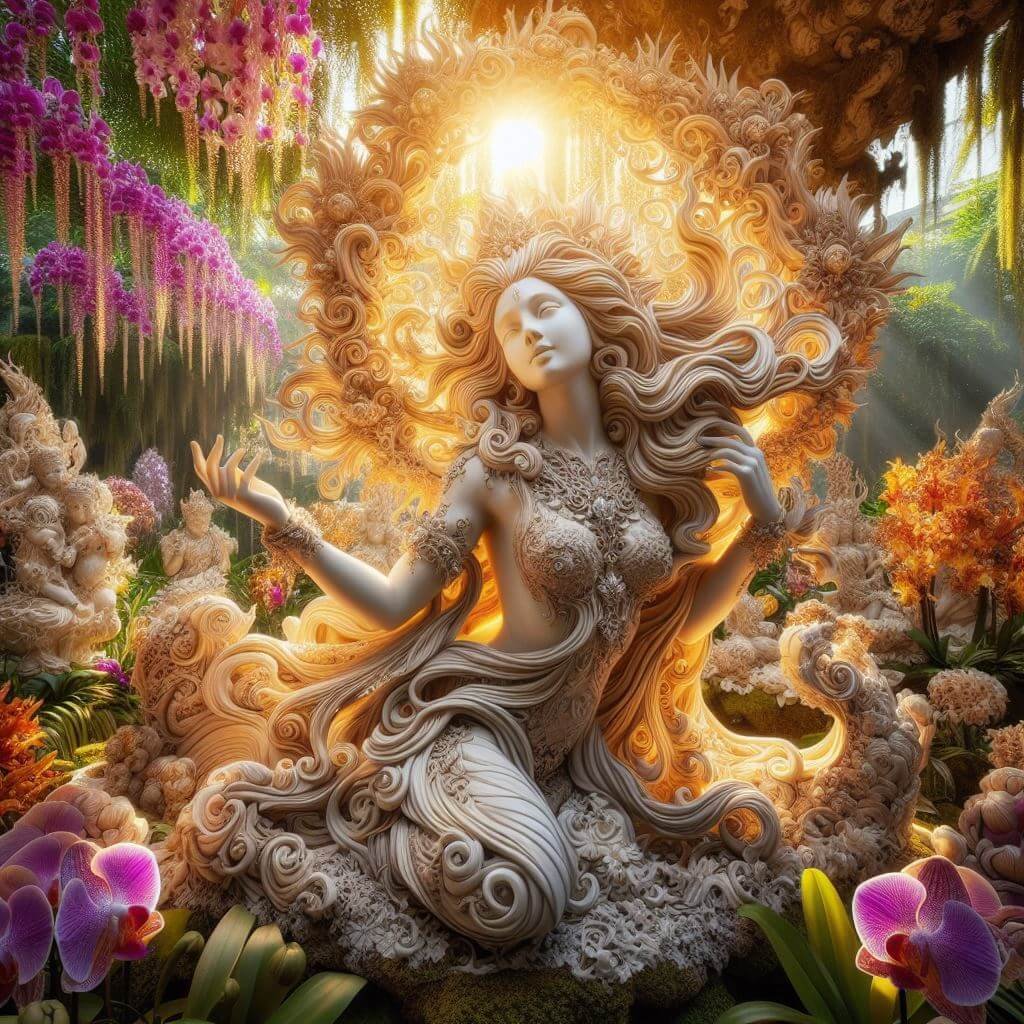Unraveling the Mystical Allure of Orchids
The Exquisite Allure of Orchids: A Global Celebration
With their otherworldly flowers melding splendor and intricacy, orchids have spellbound civilizations across landscapes and eras. These refined blooms signify prestige and wonder for emperors and artists alike. As one of Earth’s largest flower families, the orchid’s empire spans steamy jungle canopies to Himalayan granite—an adaptable mastery underpinning transcendent beauty.
Our ode traces orchids’ global habitats and pollination mastery, their starring role in medicinal traditions, the Victorian obsessions they fueled and their fragile future as biodiversity guardians. For in protecting delicate orchids, we safeguard vibrant ecosystems and human heritage worldwide.
Naturalist Gazes With Pure Wonder Upon Exotic Orchid Specimen
Key Revelations on Orchids' Mystique Across Cultures
Over 28,000 orchid species make up one of two largest flower families globally
Adapt to ecosystems from Arctic tundra to tropical cloud forests worldwide
Inspired lucrative $7 billion cut flower industry with corsage Cattleyas
Feature in Asian art symbolizing wisdom and refuge for 3000 years
Fueled deadly Victorian-era collecting craze as imperial botanical trophies
Anchor highly-specialized pollinator links across habitats and regions
Remain vital —yet endangered—components of forest biodiversity worldwide
Massive Wooden Orchid Goddess Sculpture on Bali
The orchid’s cultural cachet and ecological brilliance have captivated us for centuries...now these fragile blooms require our stewardship like never before. Global forests face grave threats, taking these floral gems and entire ecosystems to the brink. Revealing orchids’ glittering realm across habitats and eras aims to reignite our childlike sense of wonder in nature’s magic—and steel our resolve to preserving that wonder for generations unborn.
Unraveling Orchids' Allure in 2024: Global Jewels Under Siege
A Cosmopolitan Flower
Orchids command a truly global habitat, gracing ecosystems as diverse as they are. More than 28,000 orchid species span the globe, making them one of the two largest flowering plant families on Earth. Though orchids abound in tropical latitudes near the equator, these adaptable blooms also thrive in temperate grasslands, Mediterranean scrublands, and even Arctic tundra.
Famed 19th century orchid hunter William Arnold neatly captured their mystical allure:
"So then the Orchideae constitute the aristocracy of the vegetable kingdom, and excite our admiration by their many claims to distinction, whether we regard the beauty, singular forms, or remarkable qualities of their flowers, the fantastic symmetry of their varieties, or the multifarious, ingenious, and often extraordinary means to which they resort for their propagation."
The family’s reach extends to every continent except Antarctica. Asia and South America boast a particularly rich orchard biodiversity, together harboring over 75 percent of all existing orchid types. Even lands as far-flung as Alaska, Morocco, and Tierra del Fuego host native orchid species adapted to harsh or extreme climes. With such a vast empire, orchids have evolved clever ways to beguile pollinators across terrain and climate.
These cunning flowers often mimic food sources or female insects through specialized petal shapes, UV color patterns, and alluring fragrances. By outwitting their global entourage of enamored bees, flies, butterflies, hummingbirds, even moths or beetles, orchids perpetuate their cosmopolitan reign.
Orchids are found on every continent except Antarctica
They have adapted to an incredible diversity of habitats, from steamy jungles to windy tundra
The orchid family encompasses over 10% of all flowering plant species on Earth
Visions of Orchidian Wonders
Lush Tropical Treasures
Nothing epitomizes orchids quite like jewel-toned Cattleya blooms or the starburst lips of vibrant Vanda blossoms. Though orchids inhabit diverse landscapes worldwide, tropical rainforests remain their ecological bastion and aesthetic muse. Accounting for over 70 percent of all orchid species, tropical orchids are the family’s most populous and flamboyant members.
Many hail from equatorial hotspots like Brazil, Madagascar, Southeast Asia, Papua New Guinea, and Central America. These steamy, high humidity habitats allow colorful, warm-growing orchids to flourish in all their exotic splendor. Given perfect growing conditions year-round, tropical orchids can bloom almost continuously if coaxed to do so.
Their superlative flowers even inspired the extravagant corsages and lavish floral arrangements that dominate modern orchid commerce.
Though showy colors and shapes steal the limelight, vanilla planifolia offers its own humble tropical treasure - the world’s sole orchid crop. Native to Mexico and Central America, this vine’s dried seed pods supply the popular vanilla spice relished across the globe. Few realize this favorite flavoring and scent depends wholly on delicate orchid reproduction year after year.
The jewel-toned cattleya and fiery vanda orchids of steaming jungles showcase the family's dazzling color palette, from sultry crimson to verdant chartreuse. Their wondrous blooms erupt in starburst and butterfly patterns, entrancing like the mystical eyes of jungle cats.
These flowers seem to trap the very luminosity glowing through rainforest canopies in their translucent petals. Given the damp, hazy habitat, one almost expects these vibrant orchids to dissolve like mirages as we draw near. Yet their allure only intensifies, hints of musk and nectar lingering like olfactory magic as brilliant wings flutter with the mysteries of an Amazon basin older than humanity itself.
Orchid Gazing in the Himalayan Cave of Wonders
Rock Stars and Rebels
While sultry tropical orchids may rule supreme in numbers, temperate terrestrial orchids boast their own eccentric allure. Lacking gaudy colors or shapes, these modest meadow and prairie dwellers charm with tiny, elfin flowers marked by their exquisite intricacy. Terrestrial orchid habitats range from the grassy Scottish Highlands to American tallgrass prairies or South African fynbos scrublands that erupt in wildflower super blooms after seasonal fires.
These adaptable orchids thrive on symbiotic soil fungi that help them extract nutrients, allowing robust flowering even in poor soils. While tropical orchids rely on saturated humidity, hardy terrestrial orchids tolerate seasonal droughts, baking heat, even Arctic cold snaps. Diverse northern species sport curious names like lady’s slipper, helleborine, bog candle, and Calypso after the Greek nymph.
Perhaps the most eccentric orchids mimic other flora. Western Australia’s elf-like hammer orchids fruit in autumn, recalling tiny Dutch wooden clogs. Their column and flower parts create the “shoe”, complete with frilly tongue inside.
The diminutive rebels growing secretly across prairies and bogs reveal orchids need no gaudy colors or rich scents to bewitch us. These subtle blooms hide their delicate geometry inside boots and bell sleeves shaped from single impossibly thin petals. They deal in intricacy rather than immensity.
Only the initiated will uncover their fairytale treasures, like portals into whimsical poetic worlds. One must gently turn back the lady's slipper to find the precious golden slipper within, or peek down the frilly tongue inside each elfin Dutch boot. Their subtle enchantments reward not the bold but the reverent, speaking only to true believers in nature's magic.
Conservationist Studies the Mystical Allure of Orchids
Seduction by Scent
While exotic shapes and hues define many orchids, thousands of species opt for olfactory over visual seduction. Night-blooming orchids like Bulbophyllum craft pungent floral scents to attract night-flying pollinators. Their stench carefully mimics prey or fungal aromas to lure in unsuspecting fruit flies or gnats. One Bulbophyllum species even exudes the stench of rotting meat to attract blowflies.
Other orchids create more pleasant perfumes. Sharry baby orchids exude a tantalizing tropical fruit or chocolate fragrance, while lady slipper orchids conjure the sweetness of wild mountain honey. Instead of gaudy petals, these orchids invest heavily in biochemical strategies and scent innovation to reproduce successfully while reducing pressure from hungry herbivores.
For bulbose orchids cloaked in shadow, perfume and deception offer the surest paths to proliferation. They brew strange concotions that bloom only under darkness's veil. To lure their unsuspecting fly and beetle vectors, orchids' scent mimics cover far more than sweet temptation. Pungent fungal stews, musky mammalian fur, even fetid flesh make up deception's perfume.
This is seduction by subterfuge alone. And we delight in such clever treachery. For pure biochemical prowess, few can match Their cunning night blooms. No striking visuals needed when you bottle desire itself inside each tenebrous flower. The nose knows nothing of aesthetics or virtue. It simply follows the clue towards promise.
Balinese Orchid Goddess Statue
The Timeless Allure of Orchids Across Cultures
Orchids as Symbols in Art and Philosophy
In China, orchids have graced scrolls, clay pots and scholarly gardens for over 3000 years as paragons of creative genius reflecting man’s longing to match nature’s splendor. Their elegant curves came to symbolize the very wellspring of virtue, wisdom, spiritual achievement and creative passion for generations of artists and philosophers.
Literary circles incorporated cattleya and cymbidium orchids into ink wash paintings, regarding the alluring blooms as the finest embodiments of life’s ephemeral and sublime beauty. The very contour of each delicate petal evokes the mysterious harmony between man and the natural world in classic Chinese aesthetic ideals. Orchids signified the mark of the enlightened scholarly recluse as much as the alluring mystique of the mountains themselves.
Seduction and Reverence in the Ancient Americas
To the ancient Aztec and Maya civilizations, the jewel-like colors and intoxicating scent of rare orchid varietals invoked wild magic and seduction from the steamy Neotropical forests that cradled their earliest cosmologies. The sumptuous blooms became fixtures of imperial nobility, their mythic properties promising allure, virility and communion with ancestral spirits.
Revered as symbols of wealth and power for early Mesoamerican rulers, these precious flowers were presented to kings and nobles as divine offerings. The rarest and most spectacular cattleya and laelia specimens remain treasured luxury exports today, bestowed as symbols of affection and blessings at weddings across Central America for their legendary powers binding lovers together.
Massive Orchid Sculpture on the Beach in Tulum
Obsession and Empire in Victorian Britain
As the British Empire expanded its botanical riches, resplendent orchids sparked an era of feverish orchidelirium by the early 1800s. Aristocratic collectors and daring plant enthusiasts vied for the latest exotic introductions from intrepid expeditions sent to the furthest outposts of Empire. Lush illustrations circulated of otherworldly specimens adorning London parlors and fixating the Royal family.
Botanist Jane Loudon commented, "Can anything be more elegant than the poetic cypripedium, so fitly named the lady's slipper; or anything more nondescript than some of the wonderful orchids found in the equinoctial regions, which almost terrify beholders..." Backed by seemingly limitless imperial hubris and wealth, British orchid fanciers toiled to outmatch each other creating ever more elaborate crosses, transforming glass conservatory displays into the world’s first orchid spectacles that still stand today as towering feats of botanical artistry.
Harbingers of Luck and Protection
Beyond Europe’s shores, orchids have long featured prominently as cultural totems thought to safeguard health, vitality and fortune across Asia. Most Hindu religious ceremonies incorporate orchids such as vibrant Vanda blooms to invoke primordial cycles of life, death and rebirth as well as the inherent purity achieved through spiritual devotion.
Likewise, traditional Chinese medicine employs medicinal orchid tonics to restore and invigorate the vital organs while defending against diseases of affluence in modern life. Echoing Victorian era parlors, orchids now adorn Asian homes as lucky charms beckoning prosperity and harmony within families. From the mist-veiled mountain temples of Yunnan to the urban glass towers of Singapore, orchids retain a timeless aura promising blessings and balance across the realms of man.
Revel in the Exotic Allure of Orchids
Orchids: Harbingers of Myth and Mystique Through the Ages
Of all Earth’s flowering treasures, few claim mystique rivalling orchids. These refined blooms have transfixed humanity’s imagination for millennia as emblems of exotic splendor, fertility myths and luxury reserved for nobility across cultures. Today over 80,000 named orchid hybrid crosses pay homage to our enduring orchid obsession echoing back through the ages.
Divine Emissaries in Ancient Societies
Orchids featured prominently as emissaries bridging the divine and mortal realms in some of humanity’s earliest societies untold centuries ago. Jade carvings from ancient Olmec and early Maya city-states depict priest-kings adorned in precious jade and mother-of-pearl orchids as symbols of sacred communication with deified ancestral lineages and the life essence itself. These early New World societies believed multi-hued Cattleya and jewel orchids contained ch’ulel – the vital spirit force of fertility and generation intrinsic to rulers. Possession of rare orchids affirmed divine rulership.
Half a world away, Chinese antiquity echoes similar orchid veneration. China first cultivated Cymbidium orchids as early as 1000 BC in imperial gardens representing spiritual perfection. Elders imbued orchid symbolism with Confucian ideals of virtue, reclusiveness and creative passion as the highest embodiments of human character. Literary sophisticates cherished ink wash paintings of blooming orchids conveying the very harmony between man and the natural realm in Chinese philosophy.
Tropical Flowers with 24K Gold and Diamond Details
Byzantine Healers and Ottoman Aphrodisiacs
Beyond dynastic power and scholastic ideals, orchids also factored heavily in ancient medicinal traditions spanning Europe to Northern Africa. Early Greco-Roman healers noted orchids’ curious resemblance to human anatomy, incorporating various orchid poultices and tonics into medicines for reproductive issues, lung ailments, and nervous disorders.
This therapeutic legacy continued under the Turks and Moors. The prized Anatolian salep orchids figured prominently as herbal panaceas in early Ottoman pharmacology starting in the 12th century. Their starchy tubers were thought to enhance virility, aid digestion and increase strength as medicinal tonics.
Salep’s rumored restorative powers ignited commercial orchid hunting in remote Turkish hill regions. By the 17th century, flour made from powdered salep tubers emerged as a popular delicacy across Constantinople reserved for imperial families alone.
Fatal Attraction: Deadly Orchid Obsession in Europe
By the mid 1800s, the orchid craze that blossomed alongside European colonial expansion soon became deadly obsession for Victorian collectors funded by new industrial fortunes. As intrepid plant hunters scoured Empire outposts for rare prize specimens to adorn parlors, hothouses and Kew Garden’s sprawling new conservatory, demand for exotic novelties unleashed reckless overharvest worldwide.
Nowhere proved more perilous than the orchid hunting grounds of South America. Lured by legends of mythical cattleya orchids flowering only once every seven years atop hidden cloud forest peaks, waves of European explorers vanished on remote Andean climbs. Still more died from tropical fevers, native attacks or failed expeditions along Brazil and Venezuela’s lawless interior frontiers rich in elusive flora.
Hundreds paid the ultimate price feeding elite European cravings amid South American regions that remain barely explored even today. This orchid mania sparked the first early calls for global plant conservation from famed biologist Alfred Russel Wallace after witnessing the human toll firsthand.
The Orchid Goddess
Refined Infatuation Continues
While such deadly collecting quests faded by the early 1900s, the refined infatuation sparked by exotic orchids persists in modern horticulture today. Over 100,000 registered complex hybrid crosses now exist – more than any other decorative flower group. Miniature orchids like petite Jewel Orchids with candy-like blooms hypnotize hobbyists and collectors alike, even as bulldozers decimate the diminutive species’ fragile tropical habitats.
As global biodiversity faces catastrophic decline, perhaps our enduring human obsession with orchids spanning millennia also offers their conservation a lifeline. For protected by human hands, even the most endangered orchids exhibit remarkable resilience, as legendary naturalist David Attenborough once observed:
“Orchids seduce by their beauty and their splendid diversity of form. They have even, on occasion, tricked...But for me their supreme seduction lies in challenge they pose: the challenge to discover them in the wild, to identify them , and to sustain the environments in which they live.”
Our shared bewitchment promises hope yet for safeguarding these exquisite harbingers of nature’s wonder across landscapes and cultures.
Guardians of the Forest
While humans cultivate orchids as icons of artistry and status, these flowers play a critical botanical role as well. Their seeds rank among the tiniest in the plant kingdom, allowing efficient wind dispersal but little nutritional reserve. To germinate and thrive, young orchid seedlings partner with soil fungi that supply critical nutrients in exchange for carbohydrates the orchid produces.
These essential microbial symbioses underpin entire orchid lifecycles and ecology, from germination through maturity. Such co-dependencies centering on fungi make orchids especially sensitive to habitat degradation and destruction.
As old-growth canopy trees fall, crucial forest microclimates also erode, drying out once perpetually humid orchid havens. Losing these fragile orchid ecosystems undermines entire forest food webs and species rosters far beyond the orchids themselves.
In protecting delicate orchids, we safeguard intricate forest worlds that sustain wildlife, secure watersheds, warehouse carbon, and support human welfare for generations to come. Beyond beauty, orchids anchor essential ecosystem services across continents – rare magic we squander at our own existential peril.
Surreal Dreams of Orchids in Paradise
Precarious Sanctuaries
Despite their ecological brilliance and cultural cachet, orchids now confront an increasingly imperiled future worldwide. Ravenous logging, urban sprawl, and agriculture ravage delicate rainforests housing over 70 percent of all orchid species. As their intricate forest canopy habitats crash down, countless orchids wink out before we even discover them.
Based on current habitat loss rates, over 1000 orchid species already qualify as threatened or endangered. But with only an estimated 10 percent of orchids described scientifically so far, the true scope of the crisis remains unknown.
Hawaii offers the clearest warning of what lies ahead. Once dubbed “the orchid isles” for hosting up to 142 native species, Hawaii now retains just 22 endemic species in the wild. Habitat loss proved devastating - nearly 90 percent of Hawaii’s native orchids vanished before gaining scientific names or protection. Myriad tropical paradises from Jamaica to Singapore to Réunion Island echo similar tales of once bountiful orchid diversity plummeting as forests fell.
Now the biological meltdown endangers continental orchid hotspots as well. South and Central America’s plush rainforests once sheltered 4000-5000 orchid species amid ancient Kapok and Mahogany giants. But rampant land conversion for cattle, soybeans, palm oil, and urban migration devoured over 80 percent of original cover in Brazil’s Atlantic rainforest. Peru lost nearly 50 million hectares of Amazonian rainforest between 2001-2021 to logging, burning, mining, and oil drilling.
Besieged Habitats
The onslaught ravaging Neotropical forests threatens Colombia’s legendary orchid diversity perhaps most of all. Though Colombia accounts for only 0.7 percent of global land area, it safeguards a wondrous 14 percent of total orchid species - perhaps 3500 unique types overall. This prodigious orchid wonderland owes its profusion partly to the towering Andes Mountains slicing through equatorial latitudes.
As the tectonic ranges thrust skyward, they spawned an intricate mosaic of microclimates, altitudinal gradients, and rain shadows nurturing speciation. Isolated Andean valleys and foothill enclaves birthed a Carolina’s “lost worlds” hosting entirely unique orchid suites. Cloud forests festooned in lichen and bromeliads boast miniature orchids adapted to constant misty precipitation. At higher elevations, hardy lady’s slipper and dracula orchids thrive amid chilly winds and thin soils .
Further north near the Caribbean, endemic cotton candy-hued Cattleya, Brassavola, and bark-dwelling Schomburgkia orchids take advantage of balmy sea breezes and partial sunlight filtering through tropical dry forest.
The riches encompass more than flowers alone. Over 350 orchid species contribute to Colombia’s bustling “mina de oro verde” cut flower exports, second only to the Netherlands. Avon mixes essential oils from fabled Gongora orchids into premium skin care lines. And the critically endangered vanilla mexicana vine clings to last remaining Pacific coastal forest fragments, its prized aromatic seed pods once flavoring Aztec emperor Moctezuma’s personal chocolate elixir five centuries past.
Against seemingly insurmountable threats, valiant Colombian conservationists now rally behind a bold new vision - establishing an extensive network of community forest orchid reserves.They aim to preserve representative orchid species across 40 key protected sites spanning critically endangered Andean cloud forests and coastal tropical dry forests. By engaging rural communities, indigenous groups, and botanical institutions in joint conservation planning, the vision bridges both environmental stewardship and social equity.
The ambitious goal - safeguard Colombia’s legendary orchid diversity and by extension, myriad interlinked species relying on fragile orchid habitats. Early successes already shine bright on the Caribbean coast, where Afro-Colombian villages now tend native orchid-rich sanctuary forests as ecotourism assets and badges of community pride.
Give in to the Vapor Dream of Your Life
Signs of Resilience
Beyond human efforts, orchids exhibit remarkable resilience themselves when given a lifeline. Hawaii’s tragic native orchid losses once seemed irreparable. Yet today, innovative propagation programs allow 6 Hawaiian orchid species and over 1000 rescued hybrids to flourish again in protected reserves and private collections. Botanic gardens worldwide also rally around orchid restoration.
Atlanta Botanic Garden scientists perfected techniques for germinating temperamental Hawaiian spiral orchids without the symbiotic fungi they rely on in nature. Smithsonian gardens nurture high Andean Dracula orchid species salvaged from illegal poaching, while Britain’s Royal Botanic Gardens, Kew revives the legendary Victorian orchid hunter’s legacy. Kew partners with online retailer Anthropologie to clone and sell rare orchids rescued from decimated Madagascan rainforests. Sales directly support enlarging forest reserves there.
Such efforts underscore why safeguarding orchids repays global dividends. Those sensuous flowers impart deep emotional and spiritual succor while anchoring precious forest ecosystems far beyond our reckoning. They remain exquisite embodiments of nature’s wonder, fragility, and resilience - and our own humanity.
Exotic Essence
Exploring the Allure
If our ode to orchids' global splendor inspires you as deeply as it does us, we invite you to exalt these exotic muses through our exclusive Tulumination apparel collections celebrating vibrant botanical beauty worldwide.
Sliding into Infinity Vapor Dream














































































